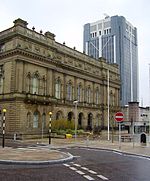Blackburn with Darwen
1974 establishments in EnglandBlackburn with DarwenBoroughs in EnglandEngvarB from September 2013Incomplete lists from January 2022 ... and 5 more
Local government districts of LancashireLocal government in Blackburn with DarwenNUTS 3 statistical regions of the United KingdomUnitary authority districts of EnglandUse British English from January 2024

Blackburn with Darwen is a borough and unitary authority area in Lancashire, North West England. It consists of the towns of Blackburn and Darwen but covers a wider area which includes the villages of Lower Darwen, Feniscowles, Brownhill and Hoddlesden.
Excerpt from the Wikipedia article Blackburn with Darwen (License: CC BY-SA 3.0, Authors, Images).Blackburn with Darwen
Ainsworth Street,
Geographical coordinates (GPS) Address Nearby Places Show on map
Geographical coordinates (GPS)
| Latitude | Longitude |
|---|---|
| N 53.75 ° | E -2.4815 ° |
Address
Ainsworth Street
Ainsworth Street
BB1 6AT , Four Lane Ends
England, United Kingdom
Open on Google Maps







